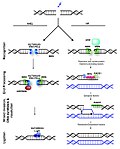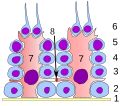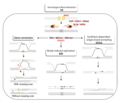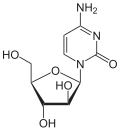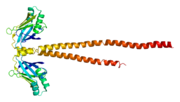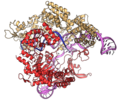Non-homologous end joining (NHEJ) is a pathway that repairs double-strand breaks in DNA. It is called "non-homologous" because the break ends are directly...
28 KB (3,683 words) - 16:38, 29 October 2024
Non-homologous end-joining factor 1 (NHEJ1), also known as Cernunnos or XRCC4-like factor (XLF), is a protein that in humans is encoded by the NHEJ1 gene...
13 KB (1,652 words) - 12:24, 7 November 2023
cells, there are two main DSB repair mechanisms: Homologous recombination (HR) and non-homologous end joining (NHEJ). HR relies on undamaged template DNA as...
36 KB (4,324 words) - 17:45, 17 October 2024
strand breaks, mainly non-homologous end joining (NHEJ), homologous recombination (HR), and MMEJ. NHEJ directly joins both ends of the double strand break...
11 KB (1,373 words) - 22:13, 6 February 2023
repair of double strand breaks by homologous recombination or non-homologous end joining, repair of single nucleotide damages by base excision repair, and...
34 KB (4,157 words) - 13:23, 31 October 2024
double-strand breaks (DSBs): non-homologous end joining (NHEJ), microhomology-mediated end joining (MMEJ), and homologous recombination (HR): In NHEJ,...
129 KB (15,900 words) - 22:25, 12 October 2024
V(D)J recombination (redirect from V-J joining)
transferase (TdT), and Artemis nuclease, a member of the ubiquitous non-homologous end joining (NHEJ) pathway for DNA repair. Several other enzymes are known...
21 KB (2,857 words) - 20:56, 28 September 2024
CpG sites within the double-strand break-associated insertion. Non-homologous end joining (NHEJ) repair of a double-strand break can cause a small number...
161 KB (18,406 words) - 14:37, 21 November 2024
Illegitimate recombination (redirect from Non-homologous recombination)
pathways by which this will occur is the repair mechanism known as non-homologous end joining (NHEJ). Illegitimate recombination is a natural process which...
8 KB (1,000 words) - 17:39, 3 December 2023
proteins that have key roles in the DNA repair processes of non-homologous end joining and homologous recombination. Mouse cells deficient for maturation of...
97 KB (11,101 words) - 11:45, 3 September 2024
Non-allelic homologous recombination (NAHR) is a form of homologous recombination that occurs between two lengths of DNA that have high sequence similarity...
5 KB (528 words) - 20:22, 9 March 2024
be repaired through homologous recombination, polymerase theta-mediated end joining (TMEJ) or through non-homologous end joining (NHEJ). NHEJ is a DNA...
106 KB (12,117 words) - 07:58, 5 October 2024
breaks Blunt ends Non-homologous end joining Nucleotide Cell cycle Telomere NHEJ Homologous Recombination Microhomology-mediated end joining Jimeno S, Mejías-Navarro...
18 KB (2,277 words) - 13:23, 26 November 2023
to tether broken ends prior to repair by non-homologous end joining or to initiate DNA end resection prior to repair by homologous recombination. The...
25 KB (3,079 words) - 18:26, 3 December 2023
double-strand breaks are introduced into the sperm DNA. The conventional non-homologous end joining pathway for repairing double-strand breaks is not available for...
6 KB (594 words) - 02:05, 27 October 2024
relies on Ku to direct it to DNA ends and trigger its kinase activity. DNA-PKcs is required for the non-homologous end joining (NHEJ) pathway of DNA repair...
32 KB (3,754 words) - 05:22, 30 September 2024
the absence of non-homologous end joining, free ends of DNA may be rejoined by an alternative pathway biased toward microhomology joins. With the exception...
14 KB (1,530 words) - 10:33, 15 February 2024
breakage-induced replication. When the homologous DNA is absent, another process called non-homologous end joining (NHEJ) takes place instead. HDR is important...
9 KB (1,265 words) - 11:50, 29 October 2024
that nonhomologous or microhomologous repair mechanisms such as non-homologous end joining (NHEJ) and microhomology-mediated break induced repair (MMBIR)...
28 KB (3,134 words) - 12:11, 11 April 2024
deficient in the ability to repair double-strand breaks by the non-homologous end joining (NHEJ) pathway are more sensitive to prolonged desiccation during...
8 KB (836 words) - 06:55, 12 November 2024
HMGA2 (section Non-homologous end joining DNA repair)
Overexpression of HMGA2 delayed the release of DNA-PKcs (needed for non-homologous end joining DNA repair) from double strand break sites. Overexpression of...
24 KB (2,915 words) - 16:03, 8 September 2023
double-strand break repair by an imprecise processes such as non-homologous end joining. Chromosome instability in chronic myeloid leukemia may be due...
24 KB (2,329 words) - 20:43, 2 October 2024
repetitive sequences, or through chromosomal breakage followed by non-homologous end joining. Inversions are of two types: paracentric and pericentric. Paracentric...
18 KB (1,941 words) - 04:14, 12 November 2024
sequences, the repair of DNA damage by the processes of homologous recombination, non-homologous end joining, DNA mismatch repair or base excision repair may...
10 KB (1,175 words) - 10:24, 15 November 2024
repair pathways: theta-mediated end joining (TMEJ). Most double-strand breaks are repaired by non-homologous end joining (NHEJ) or homology directed repair...
13 KB (1,464 words) - 06:10, 1 November 2024
Cytarabine (category Drugs with non-standard legal status)
inhibition by Ara-CTP of the DNA non-homologous end joining pathway. Thus transient DNA breakage followed by non-homologous end joining appear to be necessary steps...
19 KB (1,757 words) - 09:15, 29 October 2024
including repair of DNA double-strand breaks (DSBs) by the process of non-homologous end joining The repair function of alpha-synuclein appears to be greatly reduced...
16 KB (1,749 words) - 18:17, 1 November 2024
plants. hXRCC4 is one of several core proteins involved in the non-homologous end joining (NHEJ) pathway to repair DNA double strand breaks (DSBs). NHEJ...
43 KB (5,681 words) - 00:50, 14 June 2024
complex that binds to DNA double-strand break ends and is required for the non-homologous end joining (NHEJ) pathway of DNA repair. Ku is evolutionarily...
15 KB (1,695 words) - 15:03, 17 January 2023
inactivation or the introduction of heterologous genes through non-homologous end joining and homologous recombination respectively in many laboratory model organisms...
43 KB (5,614 words) - 14:32, 21 November 2024

